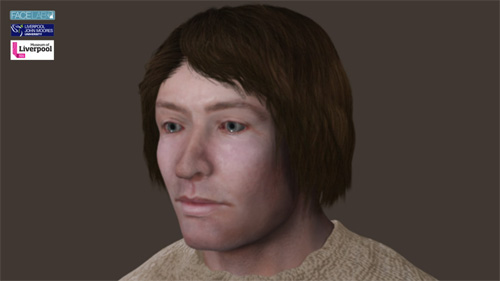
'Leasowe Man' as reconstructed by Facelab from his skull
We're delighted to have a brand new computer-generated 3D model of the face of Merseyside's oldest skeleton on display in the
Timeline in the History Detectives gallery. The facial reconstruction of 'Leasowe Man' has been created by Liverpool John Moores University's
Facelab, a specialist department which teaches and researches the skills of facial reconstruction for historical research and forensic analysis.
The face of
'Leasowe Man' provides a strong connection with this individual and raises lots of questions both about his appearance, hair colour, eye colour, and skin tone for example; and about his life and experiences.
Since his discovery in the Victorian period, 'Leasowe Man' has had a complicated history. He was found in 1864 when workmen were repairing an embankment along the seafront at Leasowe. He became known as ‘the prehistoric man of Cheshire’. Recently, however, the bones have been radiocarbon dated to between 1600 and 1900 years old so this man lived in the Roman period.
Analysis of the skeleton has revealved some information about 'Leasowe Man'. He was male and around 40 years old when he died. He was around 169cm tall, around 5'6 1/2. His bones show signs of strong muscle attachments, suggesting he was physically active during his life. Analysis of the chemicals in his bones tells us that he didn't eat very much fish, which is a little surprising for someone found so close to the sea!
The skeleton of Leasowe Man is part of the collections of the
Natural History Museum in London, accession number PA SK 137. A replica of the skull is on display in the History Detectives gallery at the Museum of Liverpool.

 'Leasowe Man' as reconstructed by Facelab from his skull
We're delighted to have a brand new computer-generated 3D model of the face of Merseyside's oldest skeleton on display in the Timeline in the History Detectives gallery. The facial reconstruction of 'Leasowe Man' has been created by Liverpool John Moores University's Facelab, a specialist department which teaches and researches the skills of facial reconstruction for historical research and forensic analysis.
The face of 'Leasowe Man' provides a strong connection with this individual and raises lots of questions both about his appearance, hair colour, eye colour, and skin tone for example; and about his life and experiences.
Since his discovery in the Victorian period, 'Leasowe Man' has had a complicated history. He was found in 1864 when workmen were repairing an embankment along the seafront at Leasowe. He became known as ‘the prehistoric man of Cheshire’. Recently, however, the bones have been radiocarbon dated to between 1600 and 1900 years old so this man lived in the Roman period.
Analysis of the skeleton has revealved some information about 'Leasowe Man'. He was male and around 40 years old when he died. He was around 169cm tall, around 5'6 1/2. His bones show signs of strong muscle attachments, suggesting he was physically active during his life. Analysis of the chemicals in his bones tells us that he didn't eat very much fish, which is a little surprising for someone found so close to the sea!
The skeleton of Leasowe Man is part of the collections of the Natural History Museum in London, accession number PA SK 137. A replica of the skull is on display in the History Detectives gallery at the Museum of Liverpool.
'Leasowe Man' as reconstructed by Facelab from his skull
We're delighted to have a brand new computer-generated 3D model of the face of Merseyside's oldest skeleton on display in the Timeline in the History Detectives gallery. The facial reconstruction of 'Leasowe Man' has been created by Liverpool John Moores University's Facelab, a specialist department which teaches and researches the skills of facial reconstruction for historical research and forensic analysis.
The face of 'Leasowe Man' provides a strong connection with this individual and raises lots of questions both about his appearance, hair colour, eye colour, and skin tone for example; and about his life and experiences.
Since his discovery in the Victorian period, 'Leasowe Man' has had a complicated history. He was found in 1864 when workmen were repairing an embankment along the seafront at Leasowe. He became known as ‘the prehistoric man of Cheshire’. Recently, however, the bones have been radiocarbon dated to between 1600 and 1900 years old so this man lived in the Roman period.
Analysis of the skeleton has revealved some information about 'Leasowe Man'. He was male and around 40 years old when he died. He was around 169cm tall, around 5'6 1/2. His bones show signs of strong muscle attachments, suggesting he was physically active during his life. Analysis of the chemicals in his bones tells us that he didn't eat very much fish, which is a little surprising for someone found so close to the sea!
The skeleton of Leasowe Man is part of the collections of the Natural History Museum in London, accession number PA SK 137. A replica of the skull is on display in the History Detectives gallery at the Museum of Liverpool.
